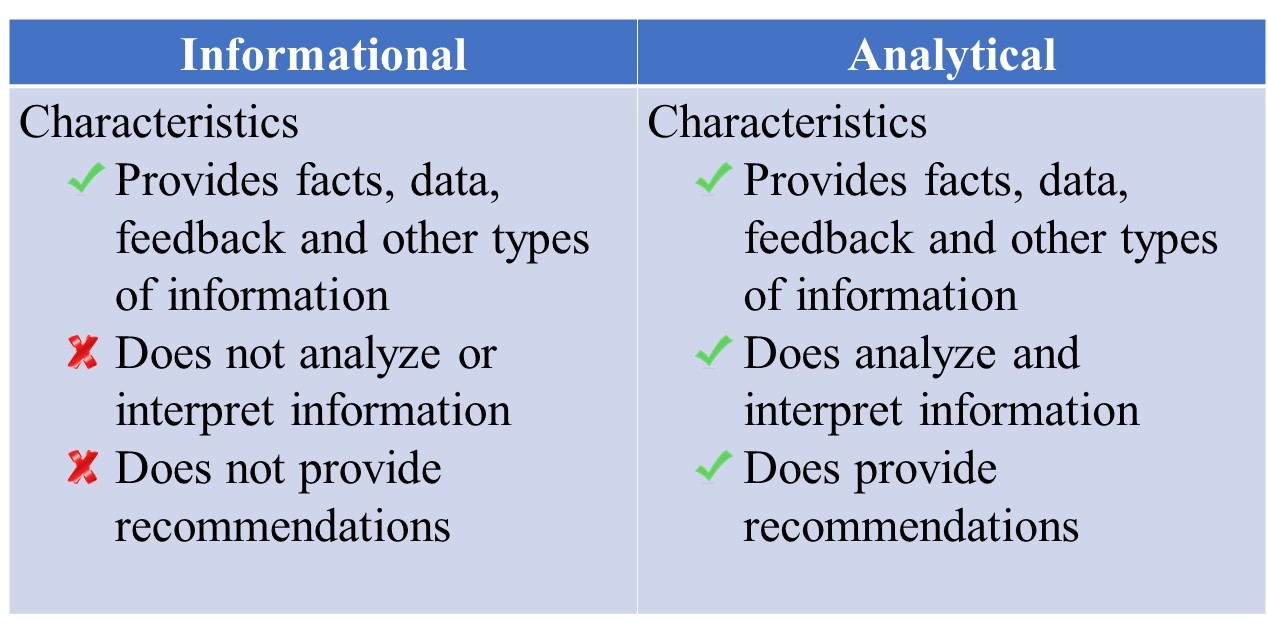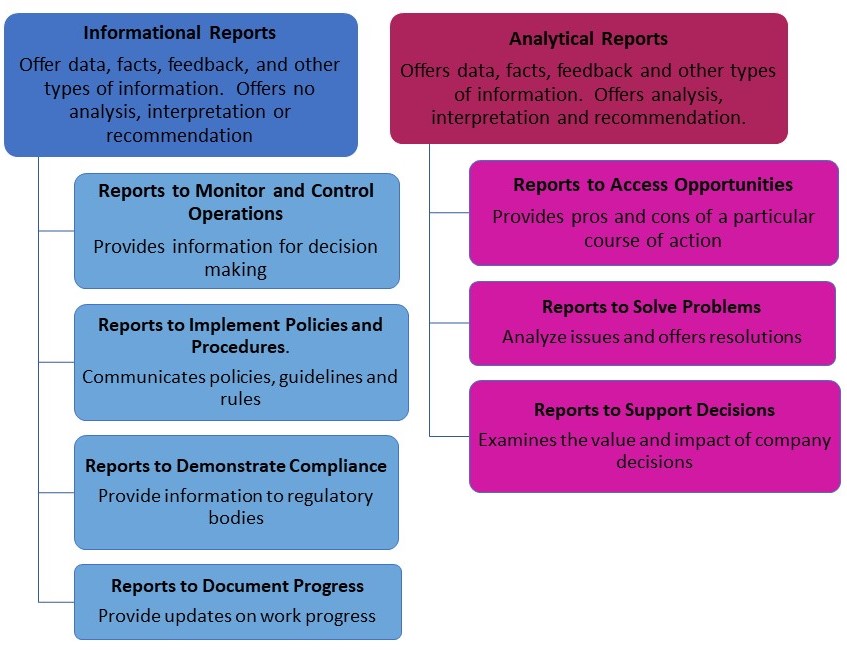Report Purpose: Informational and Analytical
Learning Objectives
 After reviewing this information, you will be able to
After reviewing this information, you will be able to
-
-
- understand the purpose of analytical reports
- understand the purpose of informational reports
-
Introduction
Reports come in all shapes and sizes—from a couple of soft-copy pages shared electronically to a book-sized binder. The type of report depends on its function as expressed in the purpose statement. The function also influences the writing style and other elements such as visual content (figures) and presentation of numerical values. Reports also vary by style and tradition. Regardless of their specific function or type, however, there are two main categories of reports: informational and analytical.
Informational reports provide facts, data, feedback, and other types of information to assist management to make decisions. Informational reports do not provide an analysis or interpretation of information and do not provide recommendations. An example of this type of “just the facts” report is a police accident report. The report will note the time, date, place, contributing factors like weather, and identification information for the drivers involved in an automobile accident. It does not establish fault or include judgmental statements. You should not see “Driver was falling down drunk” in a police accident report. Instead, you would see “Driver failed sobriety tests and breathalyzer test and was transported to the station for a blood sample.” The police officer is not a trained medical doctor licensed to make definitive diagnoses but can collect and present relevant information that may contribute to a diagnosis.
Analytical reports provide facts, data, feedback and other types of information, but they also provide analysis, interpretation, and recommendations. For instance, a field report by a Public Health Agency of Canada physician from the site of an outbreak of the H1N1 virus will note symptoms, disease progression, and steps taken to arrest the spread of the disease. It will ultimately make recommendations on the treatment and quarantine of subjects. Figure 22.1 below includes common reports that, depending on the audience’s needs, maybe informational or analytical.([1]

Analytical and Information Report Purpose
Each report purpose is best suited for specific types of reports. Figure 22.2 below provides an overview of the most appropriate business situations to use an informational or analytical report.
Figure 5.1.2 Informational and Analytical Reports
 Figure 5.1.2 provides an overview of when to use informational and analytical reports to communicate your business messages.[2]
Figure 5.1.2 provides an overview of when to use informational and analytical reports to communicate your business messages.[2]
Exercise
 Select a Fortune 500 company that appeals to you and search recent tweets and Facebook posts about it. Write either an informational or analytical report about the company you chose. In an informational report, summarize your findings in memo form or as an email. Alternatively, you could write an analytical report analyzing the strategies the company adopts in responding to tweets and Facebook posts.
Select a Fortune 500 company that appeals to you and search recent tweets and Facebook posts about it. Write either an informational or analytical report about the company you chose. In an informational report, summarize your findings in memo form or as an email. Alternatively, you could write an analytical report analyzing the strategies the company adopts in responding to tweets and Facebook posts.
References
Bovee, C., Thill, J., & Scribner, J. (2016). Business communication essentials (4th ed.). Toronto, ON: Pearson Canada Inc. Retrieved from http://www.pearsoncanada.ca/highered/product-showcase/new-solutions-for-core-foundations-from-pearson-canada/business-communication-essentials-fourth-canadian-edition-4e
Guffey, M., Loewry, D., Rhodes, K., Rogin, P. (2016). Business communication: Process and product (5th ed.). Toronto, ON: Nelson Education. Retrieved from http://www.cengage.com/cgi-wadsworth/course_products_wp.pl?fid=M20b&product_isbn_issn=9780176531393&template=NELSON
NPBComm2. (2018). Report writing. What is the type of report [Video]. Youtube. Retrived from https://www.youtube.com/watch?v=_eu9maTxHkg.
CHAPTER ATTRIBUTION
Unit 37: Report Objective: Informational and Analytical – Communication@Work (senecacollege.ca) in Communication@Work by Jordan Smith published by Seneca College is licensed under a Creative Commons Attribution 4.0 International License.
- Business Communication for Success, 2015; Business Communication Essentials, 2016) ↵
- (Business Communication Essentials , 2016) ↵

